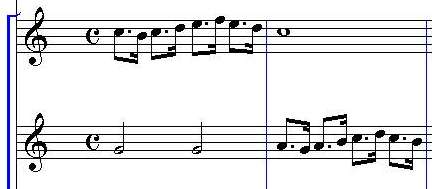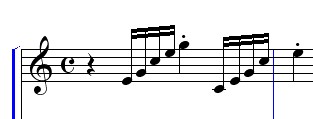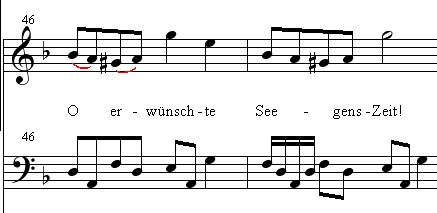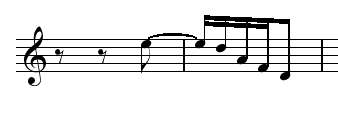Herrscher des Himmels
Herrscher des Himmels was composed for the election of the Leipzig town council in 1740, near the end of Bach's life. Two of the movements, an aria and the closing chorus, were apparently borrowed from the secular cantata Was mir Behagt, BWV 208.
Reconstruction Plan
Bach typically went all out when he scored works honoring the town council. Possibly, his stormy relationship with the council in Leipzig motivated him to put on a display of his talents whenever they were present, to show them what a valuable asset he was, and that he was deserving of their respect (particularly when a new council was being ushered in). These cantatas were usually scored for three trumpets, three oboes, tympani, bassoon, strings, and continuo (presumably, the harmonies were played on the organ). This was my assumption going into the reconstruction.
- In theopening chorus, I used a dotted rhythm typically used by Bach to express solemnity.

However, I avoided the temptation to make this the style of a French overture, which was more typical of his early works. The style is somewhat similar to that of the opening movement of BWV 140, "Wachet Auf", particularly this theme in the oboes and strings:

The middle section is a double fugue that capitalizes on the imagery of the text ("Open the heavens, bend down your ear"). There are both "falling" and "rising" images suggested by the text, as God moves closer to His people, and they strive to meet him halfway. These contrasting images helped form the two fugue subjects:

And,

- The text of the first recitative seemed more poetic than the usual declamatory text, so I added pizzicato strings and an obbligato part in the first violins to the continuo part:

- This bass aria, which follows a recitative, is also rich in imagery, comparing the sturdy palm and cedar trees to strong leadership. Bach, particularly late in his career, would have used daring leaps in the continuo to convey this tall sturdiness.

This "stretching" theme is intended to convey the same thing:

To me, upward leaps were interchangeable with downward leaps, as they could symbolize either the tall branches or the solid roots, or the eyes of an awed observer moving up and down the height of the tree.
- After another recitative, there is a soprano aria that Bach borrowed from Was mir Behagt, and later reworked as an instrumental sinfonia, then as arias in sacred cantatas. It is identifiable in its various incarnations by this charactaristic bass line:

Because Bach developed this idea several times in several different ways, I had a lot of material to work from. The surviving text suggests that the original form of the aria was used, but was twice as long as the original text. The extra text could have been "stuffed in" without changing a note of the original, or it could have been used to expand the piece. I chose the latter, and turned it into a da capo aria by assigning the extra text to a new middle section. Here, I borrowed material from both the sinfonia and the later arias, such as this passage:

- For the last recitative, I employed an antiphonal structure used by Bach on several occasions, most notably, in the recitative before the final chorus in the St. Matthew Passion. It makes use of the tenor, bass, and soprano soloists from previous movements.
- The closing chorus was also borrowed from Was mir Behagt. Like the borrowed aria, Bach used this material again in a sacred cantata, in this case, Man Singet mit Freuden (BWV 149). In the sacred cantata, Bach changed the instrumentation from horns to trumpets, moved the key from F major to D major, and made other extensive changes to accomodate the text, which bore no resemblance to the original. I was presented with a dilemma here, for the text of the 1740 cantata fit the original perfectly, but it is unlikely that he would have used the same instrumentation and key as the original. My version is therefore a compromise between the two, using the basic structure of the original with the instrumentation and key of the rework. In addition, I altered some of the passages to convey the concept of falling, since the text deals with the fire of the holy spirit falling from heaven onto the people. For instance, I took this frequently-occuring motif:

and exaggerated the "falling" motion:

In addition, I altered the chorus's opening melody. Between cantatas 208 and 149 (don't let the catalog numbers fool you, 208 was written well before 149) Bach made significant changes to the choral part. My version diverged from both. In Man Singet Mit Freuden, the line was:

which I changed to:

further reinforcing the "falling" representation.












